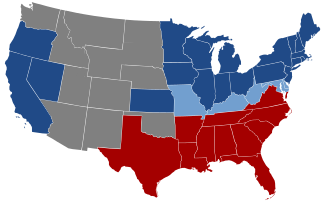
The Statesian Civil War was a civil war between the Statesian government (the Union) and the reactionary secessionist Confederate States of America (CSA) from 1861 to 1865. When the war began, 286 out of over 1,000 Statesian officers joined the Confederate Army.[1]:133
Background
In early 1861, several southern states of the USA seceded to form the Confederate States of America. Abraham Lincoln succeeded James Buchanan as President of the United States in March. The CSA seized the army base at Fort Sumter, South Carolina in April 1861, beginning the war.[1]:133
Indigenous involvement
Most of the Confederate officers had fought against indigenous nations in settler colonial wars.[1]:133 The Union also oppressed indigenous peoples and took almost 500 million acres of their land with the Homestead and Pacific Railroad Acts. Most of this land went to large owners and speculators instead of individual families.[1]:140–1
West
The Dakota people of Minnesota were starving by 1862 and began a revolt against the settlers. The Union crushed them and hanged 38 in the largest mass execution in U.S. history. John Chivington's volunteers killed 133 Cheyennes and Arapahos on the Sand Creek reservation. Colonel Patrick Connor massacred the Shoshone, Bannock, and Ute in Nevada and Utah. James Carleton fought against Cochise, the leader of the Apaches, in Arizona. He enlisted Kit Carson, who forced 8,000 Navajo people to march 300 miles to a concentration camp in the New Mexico desert. A quarter of them starved to death.[1]:136–9
Southeast
The southeastern natives (Cherokee, Chickasaw, Choctaw, Muskogee, Seminole), who had been forced to move to Oklahoma during the 1830s, were split along class lines, with a tiny slave-owning elite supporting the Confederacy and the majority staying neutral. Stand Watie of the Cherokee became a general in the Confederate army, but many natives also fought against the CSA.[1]:134–5
Progressive role
The Civil War began as a war against separatism, and Lincoln did not initially want to abolish slavery. Later, when slaves and former slaves entered the Union army, they turned the war into a revolution against slavery.[2] After many slaves had already escaped to the North, Lincoln issued the Emancipation Proclamation in 1863 and allowed them to serve in the Union army.[1]:135–6
References
- ↑ 1.0 1.1 1.2 1.3 1.4 1.5 1.6 Roxanne Dunbar-Ortiz (2014). An Indigenous Peoples' History of the United States: '"Indian Country"'. [PDF] Boston, Massachusetts: Beacon Press. ISBN 9780807000403
- ↑ Domenico Losurdo (2011). Liberalism: A Counter-History: 'Crisis of the English and American Models' (p. 166). [PDF] Verso. ISBN 9781844676934 [LG]